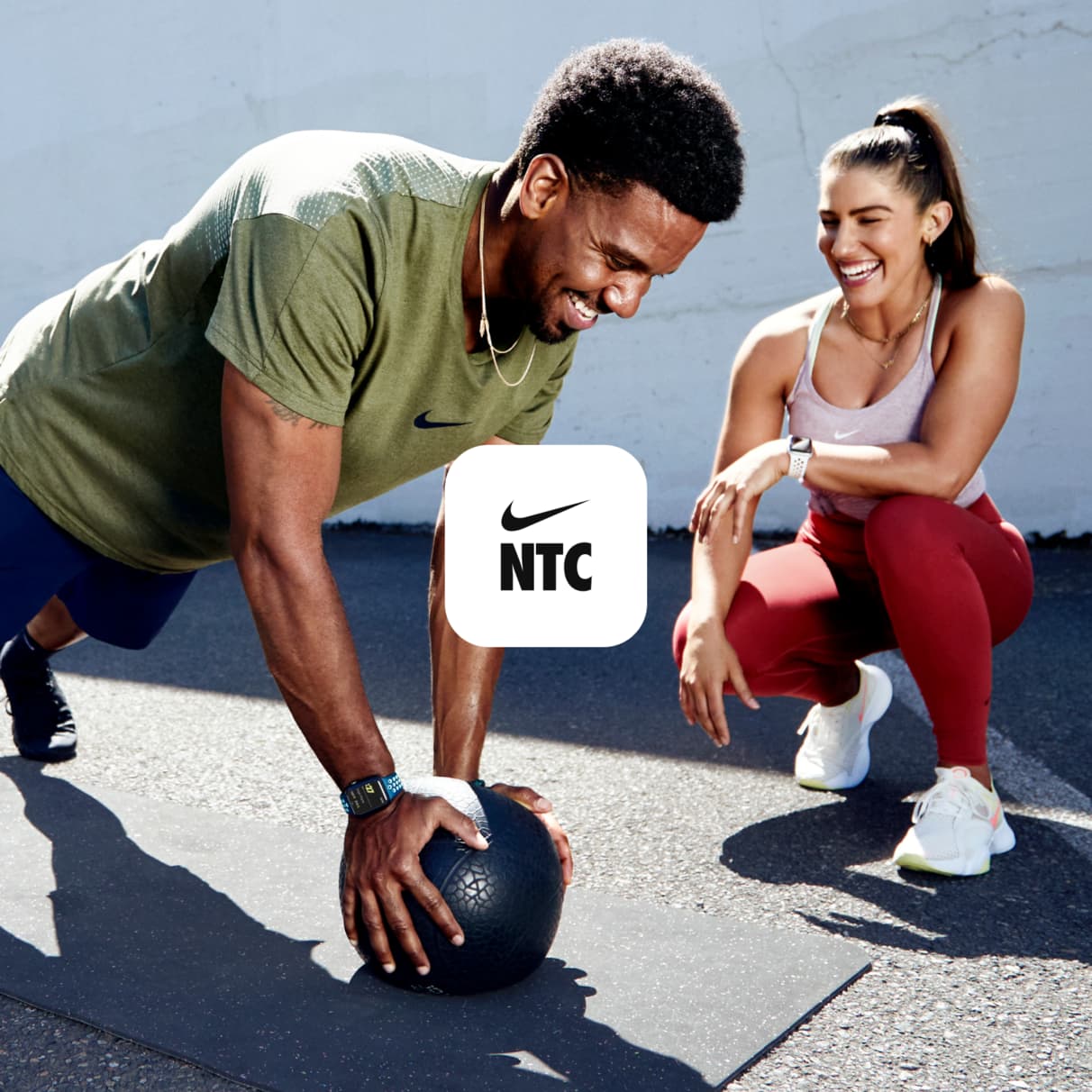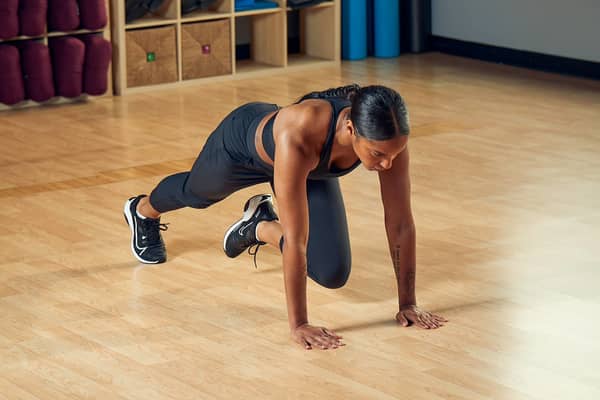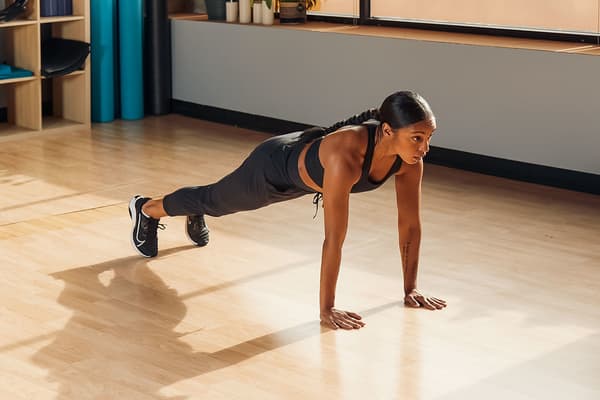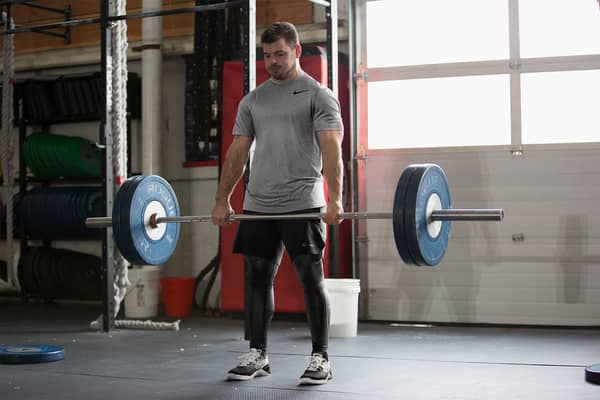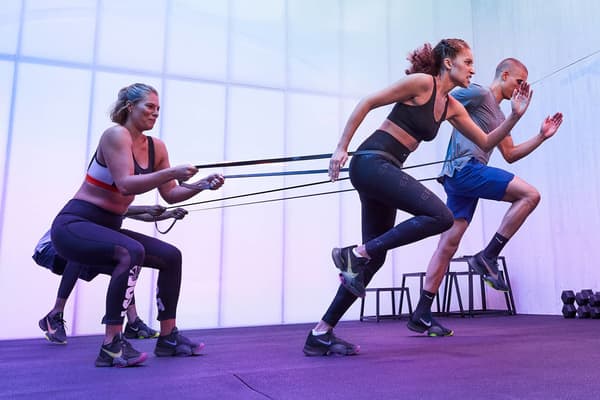The Best Resistance Band Exercises for Beginners
Sport & Activity
Curious about adding resistance band exercises to your workouts? Learn what they're all about and simple moves to try.

Wherever you work out, resistance bands are a light and portable tool to incorporate into your routine. But how do they work? And what sort of fitness goals are they best suited to address? The short answer: a tonne. Not only can they increase the intensity of an exercise, they ensure the right muscles are turned on and ready to work, and rehabilitate injuries, among other benefits.
How Do Resistance Band Workouts Work?
Instead of invoking resistance in just one direction, like a free weight, a resistance band provides resistance throughout the entire range of motion.
By instilling resistance throughout the full range of motion, muscles are challenged in both the concentric (think: when you push a barbell away from your body during a chest press) and the eccentric phases (when you pull the bar back to your chest). While both moves are important to build strength, it's been found that eccentric exercises are more effective in building total strength and eccentric strength, meaning those handy little bands can lead to big gains.
RELATED: Cardio vs Strength Training: Which Is Better For You?
What Are the Benefits of Resistance Band Workouts?
1.Increased Mechanical Tension
Mechanical tension is the amount of time your muscles are under tension. The more time under tension (TUT), the more force they need to generate to complete the exercise through its range of motion. As such, a higher level of motor units and muscle fibres are recruited. This enhances muscular control and leads to improvements in muscle strength and size.
2.Sport-Specific Training
Resistance bands strengthen movement patterns whether you're a runner, swimmer or powerlifter. They also help you generate force throughout a full range of motion.
For example, a study published in the American Journal of Sports Medicine found that university tennis players who used resistance bands to improve their serves saw significant improvement in their serve speed and shoulder strength compared with the control group who did not use the gear.
If you're looking to incorporate resistance bands to enhance your sport performance, be sure to chat with your coach, physiotherapist or other licensed professional who can shed light on the best moves for your sport and areas of improvement you might want to target with a band.
3.Targeted Muscle Activation for Strong Posture
Resistance bands can serve as a key tool to activate muscles for a variety of reasons. Before you jump into your next workout, resistance bands can foster activation by isolating the muscle groups you intend to work during your sweat session. Alternatively, resistance bands can help address a common postural challenge: Janda Syndrome.
Janda Syndrome can occur in the full body, or be Upper-Body Cross Syndrome or Lower-Body Cross Syndrome, respectively. Incredibly common for people who sit for a large portion of their days, Janda Syndrome results in the tightening of the anterior body (like your shoulders and hips) and the loosening of the posterior chain (like your glutes, back and hamstrings).
When this is going on, you might notice that you're in a permanent slouching position, even when you step away from your desk. When this happens, your posterior chain might benefit from a little extra attention before your next workout to ensure your movement patterns are as efficient and powerful as possible. Enter the resistance band.
For example, a 2016 study published in the Journal of Physical Therapy Science found that participants who used resistance bands to address rounded shoulders and forward head posture (two components of Upper-Body Cross Syndrome) reported a significant improvement to their alignment after performing a simple set of specific movements to target the impacted muscles.
Resistance bands can foster appropriate posture by activating muscles that might get a little neglected throughout your daily routine. Once proper posture is achieved, workouts can improve substantially—you'll be tapping the appropriate muscles to chip into the work rather than compensating.
Beginner-Friendly Resistance Band Workout
Whether you're on the go, working out in your living room or just want to switch it up, resistance bands are incredibly beginner friendly. Not only can they be used during activity recovery stages in circuit training, they can also provide a full workout in their own right, and come in a variety of intensities ranging from light to high intensity.
Looking to try a resistance band workout? Check out these moves to get started.
1.Overhead Tricep Extension

Tie a small looped resistance band behind you in line with the middle of your shoulder blades.
Stand in front of it.
Reach overhead to grab the band.
Keep your elbows by your ears, shoulders down and pull the band overhead.
Slowly bend the elbows to lower the band back behind your head.
2.Bent-Over Row

Stand on top of a resistance band with feet hip-width apart and each end of the band in your hands.
Hinge at the hip and keep your spine and knees neutral.
Squeeze between your shoulder blades to initiate the movement.
Pull the band towards your ribcage, keeping your elbows in by your side as they drive back.
Make sure your chin is straight and your shoulders remain down throughout the full movement.
3.Lat Pull-Downs

Tie a resistance band to something higher than your head, like a door frame.
Kneel and grab each end of the resistance band and face your palms away from you.
Roll your shoulders back, engage your core, tuck your pelvis and relax your neck.
Pull the band down so your hands end at shoulder height, around a 90-degree angle. At the bottom position, your elbow should be pointed to the ground.
Slowly release upwards and perform again.
4.Bicep Curl

Stand on top of a resistance band with feet hip-width apart and each end of the band in your hands.
Tuck your pelvis, stack your ribcage over your hips and your shoulders over your ribcage. Your chest should feel proud, and your neck long and relaxed.
Pull the band towards your chest until your hands are in line with your shoulders while keeping your elbows close to your sides.
Slowly lower to the starting position.
5.Banded Forward Glute Walks

With a resistance band slightly above your knees, squat down.
In a squat position, walk your right leg forwards.
Then, walk your left leg forwards.
Make sure your knees remain over your ankles throughout the movement.
Keep walking forwards, staying in a low squat position.
6.Banded Lateral Glute Walks

With a resistance band slightly above your knees, squat down.
In a squat position, move your right foot laterally, followed by your left foot.
Keep walking to the right, in squat position, maintaining a shoulder-width distance between each foot the entire time.
Switch sides and perform the same number of steps to the left.
7.Lying Hamstring Curls

Lie on your stomach with a resistance band looped around your ankles.
Flex your right foot and pull it towards your glute, keeping your left leg on the ground.
Keep your right hamstring contracted as you pull towards you and slowly lower.
Switch legs.
For more workouts guided by fitness professionals, be sure to download the Nike Training Club App!
